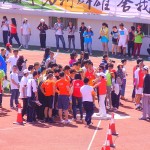JamesHowden.com is always concerned about the reading pleasure of its visitors. Because the report on my university’s June athletic competition is full of dudgeon and joy, it has been split into two parts. (Well, okay, my bride also said, “It’s too darned long!”) This is Part 1, while Part 2 is here.
I wrote earlier about the (nearly) annual Sports Day at my university (though that story only covered the day’s first 90 minutes). It is a mark of how deeply North America-centric I was (and likely still am) that I was mildly shocked, on arriving in China four years ago, to find that universities had no sports teams. The alliance between higher education and elevated levels of sporting competition is mainly an American thing, so I should’ve known; non-academic sports clubs and academies are the rule in Europe, Asia, and South America.1 There are glorified intramural basketball or volleyball games involving different faculties, which sometimes draw hundreds of drumming, shouting supporters. Yes, and there is (usually) a track and field meet, bumped off the schedule last year for the 60th anniversary commemorations of my university.2 In my earlier piece, I didn’t get past the pageantry, so here, by popular request3, is the sporting part of the story.
1 I may have been fooled by watching Kung Fu Dunk, starring Taiwanese singing sensation Jay Chou, known here as Zhou Jielun, on my first flight to China in 2009. A disgraced Shaolin monk (Chou, whom you might have seen as Kato in the movie version of The Green Hornet), is recruited by a semi-criminal sleazeball to transfer his other-worldly martial skills into stardom in the C.U.B.A. (Chinese University Basketball Association). It was spectacularly and delightfully bad. Anyway, only a few prestigious universities participate in the CUBA, which it turns out is mainly a place to enroll unqualified students – those who came up through State basketball academies, but have no future as pros – for the glory it will cast on school administrators. Hmm. Maybe it’s not completely different from American schools…
2 That day had pageantry and enforced student enthusiasm by the bucketful, so apparently there was no need for running and jumping that year. This reinforces my suspicions about what this “athletic meeting” is for, and for whom.
3 Well, my buddy JP has been bugging me about it. And my wife. That’s popularity!

A view of the finish line area from across the infield: officials, marshals, timers, medical volunteers, team spirit leaders, and a bunch of random people milling about. Photo: J.P. Mayer
Once the marching college representatives and the dancing student council conscripts had left the field, I went looking for JP. All my other colleagues had made themselves scarce, but I knew JP was there somewhere. His wife’s a staffer at another college, but he’s a free agent: photographer, ping-pong enthusiast, on-campus foreign uncle. He comes to the meet under no professional compulsion, but only because he loves this stuff, even as it frustrates the track-lover in him. This is a guy who coached high school track ‘n’ field for decades, a decathlete who competed at a World Master’s meet in his late 50s. This is a guy who used to go off to a field in his northern Ontario town, just him and his discus, to get some quiet time away from family and work as he threw and retrieved, threw and retrieved, a peculiarly sweaty kind of sunset spiritual practice. (It may seem a long way from Vipassana, but it sure sounds like meditation to me.) It took me until lunchtime to find the Coach, and then we spent the afternoon hopping from event to event.
I had missed this extravaganza at my previous university, since I was (barely) attached to a tiny post-graduate department and had little contact with other staff, and no marching orders. My wife, in her first year at our current school, had inquired of JP about what she’d miss if she contracted a sudden mysterious illness on the morning of Sports Day. Here is an edited version of his reply about the day:
“Official entrance might be at 8 a.m. or 8:30. Or 9. It’s a mystery. You will be herded together and then asked to walk in pairs, in step, looking to the right at the leaders and saluting when you pass the centre of the grandstand. Sometimes I think this is the most important part of the day. After you pass by the central grandstand you will continue marching around the track to the opposite side of the field. There, you will turn onto the infield grass (a great honour4) and line up in perfect rows facing the leaders who are sitting in their seats in the red section, which is not accessible from the stadium. They will declare the games open and you will go sit in your assigned seats to watch the spectacle, in the direct sun, with all your teacher friends5, most of whom you have never seen before and you may never see again.
“This is when they bring out the equipment, like the high jump standards and the big mats that the students have never seen before in their lives. The participants will probably all shudder collectively at the sight of this equipment and wonder how high the bar will be first set. Since most of the participants have never jumped in their lives, nor have they ever been allowed to practice, they start asking their competitor friends if they know how to do this and if they can give them any pointers. The same is happening at the long jump and triple jump pits, where they will see the sand for the first time and the wooden take-off boards will be dusted off and brought out for all to admire. Unknown to the triple jumpers, the board will be set at over 10 meters and only 1 or 2 students will actually be able to reach the pit. Most will have new spiked shoes for the occasion but no clue as to how to do the triple jump. Their next thoughts will be set on how to do this without losing face.
“It’s not all a disaster as you will see a few good races and others where the runners completely ignore those pesky white lines on the track. They will look like a Chinese traffic jam, weaving and bobbing. I really don’t understand why you would want to miss this, the greatest celebration of the year!”
4 Our university has since replaced the grass with artificial turf, which seemed sad to me until I noticed that students now use the infield, often just as a quiet green place to sit with classmates or a girlfriend. My previous school did the opposite, laying grass down; I was initially jazzed that soccer players and students would have a chance to play on the real thing – which meant so much to me in my Canadian youth – until I realized that this meant the infield would now be off-limits except on Dignitary Days. Look how lovely our grass is! Three days a year, TOPS. Argh.
5 Maybe they don’t try to force the foreigners to stay anymore – we were implored to come “only for one hour”, and after the opening ceremonies, the foreign staff disappeared.
So I knew what to expect, though as the 100-metre heats went off, I’d clearly forgotten part of JP’s description. I was surprised to see nearly every runner in track spikes. They’re only about 120 yuan, it turns out (maybe 15 bucks), and they buy them on Taobao (China’s E-bay) a few days before the event. (Track spikes must race around the country by courier, as most schools have a meet, most years.) Surprisingly, only one runner, a relay anchor from my college, trying desperately to avoid finishing last after a botched exchange, caught his spikes in the rubberized track as he lunged at the finish line, executing a spectacular tumble and getting high hero-scores from the xiao jie (young ladies).
Contrary to JP’s earlier experience – three years ago, he gave up trying to get pits uncovered and take-off boards out of mothballs, when after miles of red tape he was told they could be brought out for practice if he specified the one day and the hour over a month in advance – the shot-puts had been out a few times in the two weeks before the meet. JP had managed to coach some of the kids, and was pleased that one of his protégés
learned enough technique and leg leverage that he beat the weight-room narcissists (and the fat kids) who just muscled the shot with their ever-growing guns (and bellies).
At the high jump pit, I saw styles I hadn’t seen since my eighth-grade Field Day, when Dick Fosbury and his patented “Flop” were yet to be heard of, the pits were lined with 4 inches of fresh sawdust, and the majority of jumpers landed on their feet after doing the “scissors” technique. Here, as with the rest of the events, the mats were of adequate quality, but nobody had used them before, at least not since their previous once-yearly appearance or perhaps if they attended one of the better-equipped high schools. Even those who went over headfirst and backwards, the “floppers”, mostly landed on their bums instead of their shoulders. One tall lad from our college basketball team – School Champs! School Champs! 32-7 winners in the Final Match! – had obviously watched the high jump competition at the London Olympics quite carefully. He had an aggressive, and fairly well-timed, curving approach and a little jumping power, though he didn’t really know how to drape his back over the bar (and, at 6’4”, he doesn’t even dunk in basketball warm-ups). Two other competitors nudged him out at the end by adding his approach to their better leaping ability. I think they jumped about 5’11” (1.8 metres, about my height), to win.
Between jumps, I watched the heats of the 400 Metre Death March for Young Women (not its real name). The women’s races (they routinely giggle and insist on being called “girls”, even at 21 or 22, which alternately charms and alarms me) were the most compelling ones, though not mainly for athletic reasons. The average girl gets little athletic opportunity or encouragement here. The boys get more, and may even have some athletic experience in front of the occasional crowd, though most have never had any chance to be coached or to work with a real team. For the young women, though, the meet’s need for many names to fill the entry lists – the need for Show – means that many who have rarely run are suddenly conscripted into short pants and spikes. (This is not to mention the young woman who trained for the 400-metre race she’d been signed up for, only to arrive on Sports Day to the news that she’d be doing long jump, instead.)
I’ve run on the school track fairly often this spring, finding the boredom of circling outweighed by the lack of spastic traffic and car exhaust, and the new rubberized track is a little easier on my antique ankles and knees. As Sports Day approached, I began to share the track with more and more would-be runners, more women than men. It was nice to see, and I liked the athletic company, though there were nearly always as many walkers as runners, and some of the runners looked pretty grim about the whole thing. On the day of the meet, I saw why their training looked so dour. They weren’t exactly staring death in the face, but they were seeing his pimply younger brother…
This was Part 1 of the ‘Sports Day’ report. Part 2 is found here.


